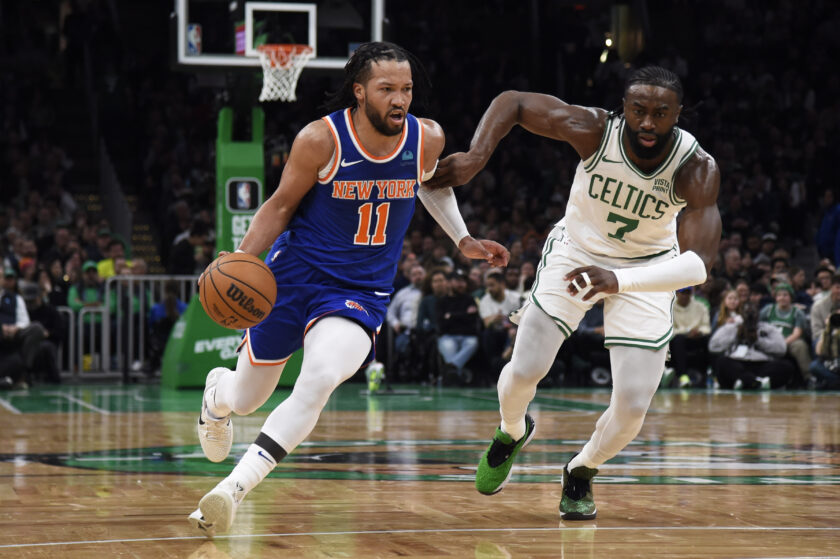New York Knicks: Drafting the all-1980s starting lineup

The 1980s were truly a roller coaster decade for the New York Knicks, but didn’t stop key players from starring at Madison Square Garden.
[sc name=”josh-benjamin-banner” ]Looking back at New York in the 1980s, it certainly was a strange era.
Everyone traded the blue-collar mystique of Saturday Night Fever for the glamour and glitz of Miami Vice. The nation went nuts at a little old lady’s, er, provocative question. Larry Bird and Magic Johnson taking their college rivalry to the pros kept the NBA captivating before Michael Jordan arrived in Chicago.
And in the midst of all this, the New York Knicks were still trying to get back to dynasty mode. The post-1973 rebuild didn’t exactly go smoothly. As a result, New York basketball was something of a roller coaster in the 1980s. There were plenty of highs, but more than a few lows.
The good news is despite it being a streaky decade, the Knicks and their fans got to experience some truly special players. A franchise icon debuted, an underrated gem was drafted, and even a league superstar stopped by for a few years.
Put on your acid-wash jeans, snap on that snap bracelet, and turn on some Wham!. It’s time to draft the New York Knicks’ all-1980s team.
PG: Mark Jackson (Knicks tenure: 1987-1992, 2001-2002)

It was hard to be a New York Knicks fan and not like Mark Jackson. Not only did he play his college ball at St. John’s in nearby Queens, but he grew up in Brooklyn. The Knicks were, in a word, his team before he even put on a uniform.
Sure enough, New York drafted Jackson at No. 18 in 1987. Though three future Hall of Famers in David Robinson, Scottie Pippen, and Reggie Miller were drafted ahead of him, Jackson had the last laugh in year one. He averaged 13.6 points, 10.6 assists, and 2.5 steals per game en route to being named Rookie of the Year.
Jackson also had the bad luck of being drafted shortly before the New York Knicks’ coaching carousel fired up at full power. He had played for four different coaches by the time he’d spent five years in the league, which also meant his playing time fluctuated.
Jackson was sent to the Clippers in the Doc Rivers trade in 1992, but still enjoyed a long career. All in all, including a brief stint towards the end of his career, he posted 11.1 points and 8.0 assists per game as a Knick. He is also fourth on the all-time assists list.
He was never a superstar, but Mark Jackson was always reliable. Especially for the New York Knicks.
SG: Gerald Wilkins (Knicks tenure: 1985-1992)
Though not nearly as popular or talented as big brother Dominique, Gerald Wilkins still carved a nice place for himself in NBA history. The New York Knicks made him a second-round pick out of Chattanooga in 1985, and to say he was a steal is an understatement.
While Patrick Ewing manned the middle, Wilkins proved reliable as a scoring guard. He posted 12.5 points per game as a rookie before upping his output to 19.1 per contest a year later. All in all, Wilkins averaged 14.9 points and sho 46.1% from the field as a Knick. With John Starks waiting in the wings, he left in free agency in 1992.
Was Wilkins an elite player? Absolutely not. He posted a sub-.100 win shares per 48 minutes (WS/48) as a Knick and didn’t play defense. Still, as the young Knicks built their next core, his contributions in the scoring department helped.
Oh, and not being afraid of Michael Jordan throughout his career also helped.
SF: Bernard King (Knicks tenure: 1982-1987)

Bernard King cost the New York Knicks flashy combo guard Micheal Ray Richardson, not to mention a draft pick, but he was worth it. The Brooklyn native was still just 25 years old when New York acquired him from the Golden State Warriors. More importantly, he had averaged 21.9 points per game on 53.4% shooting for his career at that point.
And in an instant, the Knicks had a star. King made an immediate impact as the Knicks made the playoffs in his first two seasons, only to lose in the East Semifinals both years. In his third season, he led the league with a career-best 32.9 points per game.
However, this accomplishment was bittersweet. 55 games into the 1984-85 season, King suffered a horrible leg injury that included a torn ACL on top of breaking the leg. He missed the entire 1985-86 season and played just six games for the Knicks the following year. King was then not retained in free agency.
But despite his New York Knicks tenure’s untimely and unfortunate end, Bernard King was an excellent Knick. He averaged 26.5 points per game in a New York uniform. In the same season he suffered his injury, he scored 60 points in a game, and New York still lost. The man just never stopped, and it’s a shame his Knicks career ended almost as quickly as it began.
PF: Louis Orr (Knicks tenure: 1982-1988)
This was a tough spot to fill. The New York Knicks of the 1980s had something of a revolving door at power forward until trading for Charles Oakley, and a new decade began once he hit his New York stride.
Thus, the one constant presence at both forward spots for the Knicks in this era was Orr, a former second-round pick out of Syracuse. New York traded a second-round pick to the Indiana Pacers for Orr, and he was serviceable both on the wing and at the 4.
Orr averaged 9.3 points and 3.5 rebounds per game as a Knick. He wasn’t a flashy player. At all.
Despite that, Orr proved durable and reliable in his first four years in New York. Sometimes, all New York Knicks fans want is a player who shows up to work and plays. In the case of this team, Orr has this spot locked down almost by default.
C: Patrick Ewing (Knicks tenure: 1985-2000)

You were expecting maybe Bill Cartwright? That would be valid, especially since Cartwright averaged 17.9 points and 7.6 rebounds for his first five NBA seasons, all with the New York Knicks.
However, Cartwright missed the 1984-85 season with a foot injury and questions about his overall durability remained. Thus, after landing the No. 1 pick in a controversial inaugural draft lottery, Knicks GM Dave DeBusschere struck while the iron was hot. The pick was used to select Ewing, who had become a household name while starring at Georgetown.
The rest, as they say, is history. Patrick Ewing overcame injury struggles in his first two seasons to become the New York Knicks’ most dominant franchise center since Willis Reed. In his first five years with the team, he averaged 22.9 points, 9.3 rebounds, and 3.1 blocks per game.
Obviously, Ewing did so much more for the Knicks outside of his 1980s numbers. Still, his dominance in this decade set the tone for much of the rest of his career.
Josh Benjamin has been a staff writer at ESNY since 2018. He has had opinions about everything, especially the Yankees and Knicks. He co-hosts the “Bleacher Creatures” podcast and is always looking for new pieces of sports history to uncover, usually with a Yankee Tavern chicken parm sub in hand.





